Voter Engagement and Satisfaction with California’s Local School Governance

Summary
In this brief, we use data from the 2021 PACE/USC Rossier Poll to report on California voters’ attitudes towards and engagement with local school district governance. Generally, our findings show relatively high support for school boards among California voters, although voters were less satisfied with school board performance in the context of the pandemic. Patterns of engagement also changed during the past year: some voters, particularly parents and higher income individuals, became more engaged in educational issues; others felt compelled to be more involved because they were unhappy or dissatisfied with educational systems. Our findings also highlight patterns of racial, socioeconomic, and partisan divisions in school district governance. In particular, Black voters and low-income voters were most likely to report dissatisfaction and feel less valued by their local school boards.
Introduction
California has long invested in local control of its K–12 public schools. While the state’s education code directs many actions, local leaders in the 1,037 school districts retain considerable authority over decisions governing how children are educated. School boards are particularly influential, providing fiscal oversight and accountability for the actions of professional administrators and educators. In 2013, state leaders doubled down on this belief with the Local Control Funding Formula (LCFF), a finance and accountability system granting district leaders more say over the allocation of state funding. State requirements for stakeholder engagement in LCFF decisions further endorsed principles of local control—defining new roles for parents, educators, and other community members.
The events of the past year have put local control to the test. While the majority of California schools closed in March 2020, state leaders left decisions about reopening and the nature of online, hybrid, and in-person learning during the pandemic to local leaders. Faced with often competing pressures from parents, public health officials, educators, and their unions, as well as intense media attention and public scrutiny, school boards were asked to make consequential decisions affecting the education, health, and well-being of millions of children (and their families). Social unrest and heightened awareness around issues of racial injustice during this past year also compelled some school boards to act—be it through proclamations that Black Lives Matter, renaming schools, or instituting new programs and curricula focused on highlighting structural racism.
In this report, we take stock of the local governance of public schools during the turbulence of the past year. During the LCFF years, we learned from past PACE/USC Rossier polls that, despite state and local efforts to engage the public in local education decision-making, few voters were aware of these opportunities and even fewer participated. Yet many voters also expressed interest in being involved in decisions affecting local schools. Years of research also demonstrate that voter turnout in local school board elections is consistently low and that lower income and historically marginalized individuals are less likely to participate in district decision-making. Now, the pandemic has created new local dynamics; most importantly, public education has moved to the center of public debate, and political and racial polarization has increased statewide. How have the events of this past year affected local engagement in educational decision-making? To what extent were voters engaged in local educational decisions and issues, and why? How do they perceive their local school boards, whose members are ostensibly elected to represent voter needs and interests?
We answered these questions using data from the May 2021 PACE/USC Rossier poll of registered California voters to highlight five main findings:
- Voters rated boards as generally effective, but they felt less positive about board impact and performance during the pandemic, with divisions by race/ethnicity and party
- Voters were similarly divided on whether boards were responsive to community needs during the pandemic
- Voters wanted to be more involved in education decisions and felt that boards valued their input, with important differences along race and party lines
- Voter involvement in educational issues changed substantially during the pandemic, especially for parents
- The biggest reported drivers of increased voter engagement in educational issues were dissatisfaction with education systems and increased prominence of education in public discourse
1 Voters rated boards as generally effective, but they felt less positive about board impact and performance during the pandemic, with divisions by race/ethnicity and party
When asked whether school boards have a positive or negative impact on the quality of education in K–12 schools in California, voters were split. More voters believed school boards had a positive impact (44 percent) than negative (32 percent), and only a small percentage believed they did not have much impact at all (6 percent, with 18 percent reporting “don’t know”). As Figure 1 shows, perception of school board impact varied substantially by voter characteristics; the majority of Democrats (54 percent) reported a positive impact while 46 percent of Republicans reported a negative impact. And more Black (50 percent) and Latinx (51 percent) voters also felt that the impact was positive, compared to White (43 percent) and Asian (36 percent) voters. We also observed differences based on whether voters were parents: 59 percent of parents believed boards had a positive impact compared to 40 percent of non-parents.
Figure 1. Perceptions of School Board Impact on the Quality of Education in K–12 Schools in California
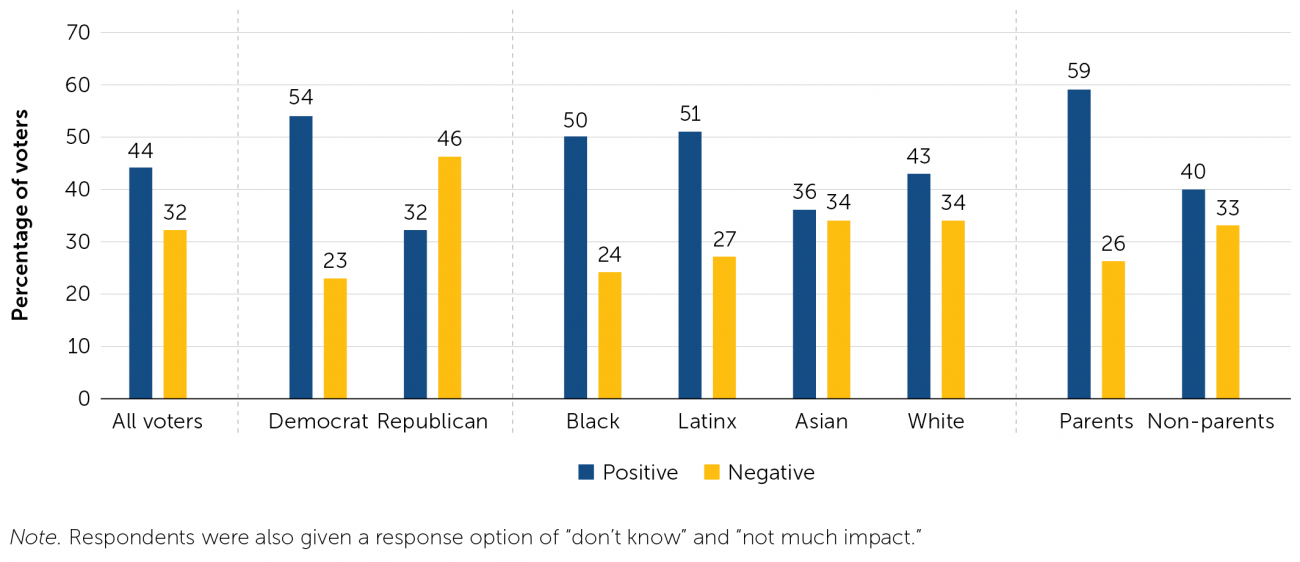
At the same time, school boards had the lowest approval relative to other public officials when voters were asked about board handling of education during the pandemic (see Figure 2). Nearly half of voters approved of how school boards handled the pandemic, but their approval (47 percent) trailed behind that of other officials, particularly public health departments (66 percent), which also played a highly prominent role during the COVID-19 pandemic. Approval was also heavily associated with political affiliation: although 55 percent of Democrats felt that school boards handled pandemic schooling well, only 39 percent of Republicans felt the same.
Figure 2. Approval of the Reopening of Schools and Educating Students During the Pandemic for Various Local Leaders
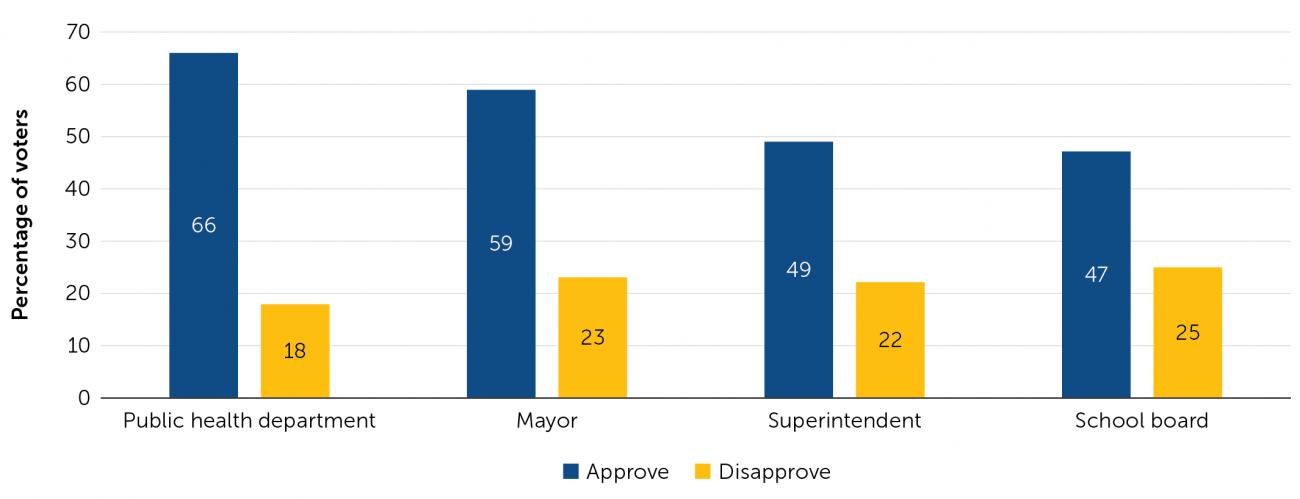
In general, voters seemed to have a more negative view of the school board’s role during the pandemic than historically. In the poll, we asked a series of questions in which we asked half of the respondents about their perceptions of school boards in general and the other half about their perceptions of school boards during the pandemic. While 58 percent of voters believed that local school boards effectively manage schools “generally,” only 45 percent agreed that this was true “during the pandemic,” with substantial differences by party affiliation (see Figure 3).
Figure 3. Perception of School Board Effectiveness in Managing Schools, Generally and During the Pandemic
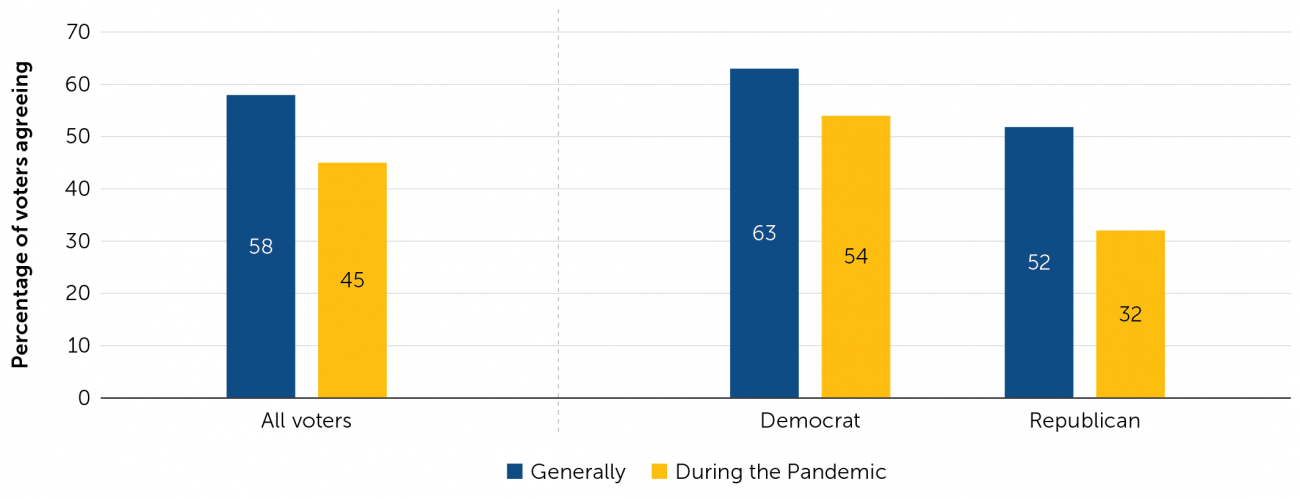
These partisan divisions are consistent with other findings from this poll, which show that 78 percent of voters believed that the state of California was becoming more divided politically, and 70 percent felt it was more divided on matters of race. California voters still felt that those divisions existed in their own communities but were not as extreme, with 59 percent believing their local communities were more divided politically and 47 percent on matters of race.
2 Voters were similarly divided on whether boards were responsive to community needs during the pandemic
One of the primary arguments in favor of school boards is that they should be well positioned to represent community constituents’ local needs and interests in education decision- making because they are locally elected members of the communities they serve. Indeed, a large majority of voters (63 percent) agreed that school boards are generally important because they ensure that decisions in education are made close to those who will be affected. However, when framed around the pandemic, only 51 percent of voters believed this was true.
Yet Figure 4 suggests large variation by income in whether voters perceived that boards have lived up to their charge of responding to their communities. While higher income voters
in our sample felt the most positive about board responsiveness in general, they were less likely to view boards as responsive when framed in terms of the pandemic. Conversely, lower income voters were more likely to view boards as responsive during the pandemic.
Figure 4. Agreement that School Boards Are/Have Been Responsive to Community Needs, by Income

We also observed that Black voters were more likely to rate school boards as responsive when framed during the pandemic than in general. While only 44 percent of Black voters felt that school boards were responsive to community needs in general, when framed in the context of the pandemic, this number jumped to 57 percent—the highest percentage among all groups. At the same time, White and Asian voters felt less in agreement that school boards were responsive during the pandemic (from 51 percent to 49 percent and 47 percent to 44 percent, respectively).
3 Voters wanted to be more involved in education decisions and felt that boards valued their input, with important differences along race and party lines
Just over half of voters polled in 2021 wanted to be more involved in decisions about education in their community (although this percentage has decreased steadily over time, from 68 percent in 2016 to 52 percent in 2021). However, we found that voters’ interest in involvement in education decisions and their trust that school boards would value their participation was divided along the lines of race and political affiliation. Figure 5 shows that, in aggregate, about the same proportion of voters (52 percent) wanted to be involved as they trusted that their input would be valued. This changes when we examine voter perceptions by race/ethnicity and party affiliation. Black (64 percent) and Latinx (59 percent) voters were more likely to express interest in being involved than White voters (48 percent). At the same time, Black voters expressed the lowest level of agreement (49 percent) that their input would be valued when making important decisions. Democrats were much more likely than Republicans to indicate they wanted to be more involved (56 percent and 49 percent, respectively) and similarly felt that their input would be more valued (60 percent and 42 percent, respectively).
Figure 5. Interest in Involvement and Trust that School Boards Would Value Input in Education Decisions, by Race/Ethnicity and Party
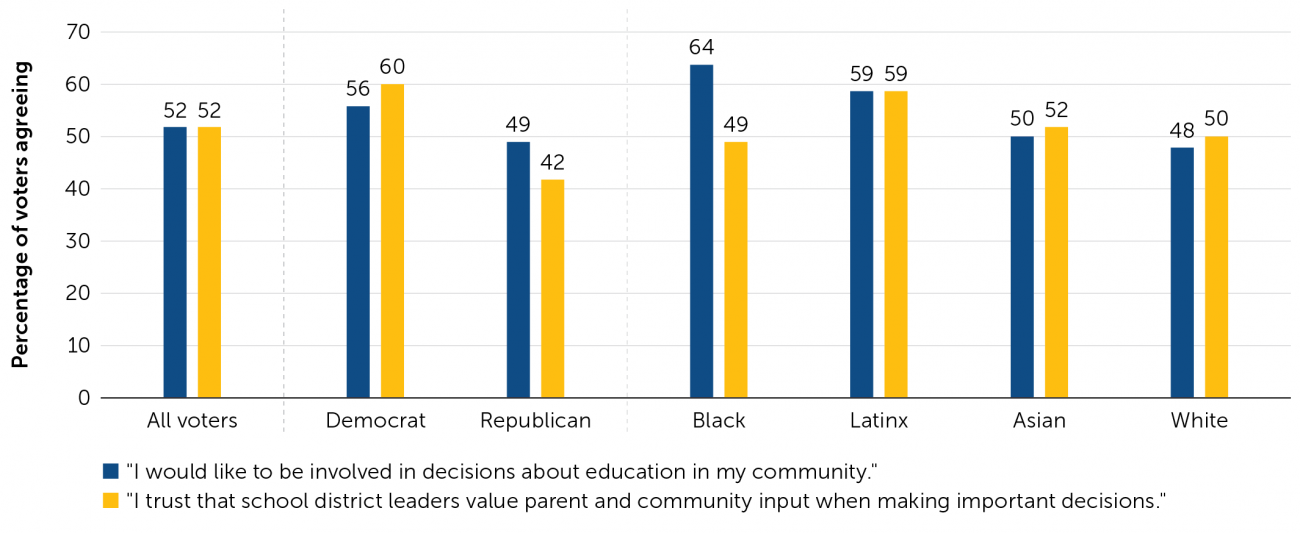
4 Voter involvement in educational issues changed substantially during the pandemic, especially for parents
The COVID-19 pandemic had far-reaching effects on voters’ reported participation in local education issues. Education issues, particularly around school closures and reopening, impacted millions of Americans. As Figure 6 shows, 34 percent of voters reported following news on local and state education policy decisions more in 2021 than they did before the pandemic. In contrast, when asked about other forms of engagement, the patterns were varied. Many voters indicated they had become less involved—or their involvement had stayed the same (representing the majority of voters in each category)—in areas of direct political activities, including contacting local officials, attending board meetings, contributing to or organizing campaigns, and attending or organizing protests.
Figure 6. Voter Involvement in Public Activities This Year Compared to Before the Pandemic

Our results were complicated by two groups: parents and higher income voters. Not surprisingly, parents stood out as the most engaged in education issues of any group in our sample. Figure 7 indicates that more parents became involved than non-parents in every area of political engagement compared to last year. For example, only 6 percent of non-parents attended board meetings—either online or in person—compared to 27 percent of parents.
Figure 7. Voter Involvement in Public Activities This Year Compared to Before the Pandemic, Parent and Non-Parent
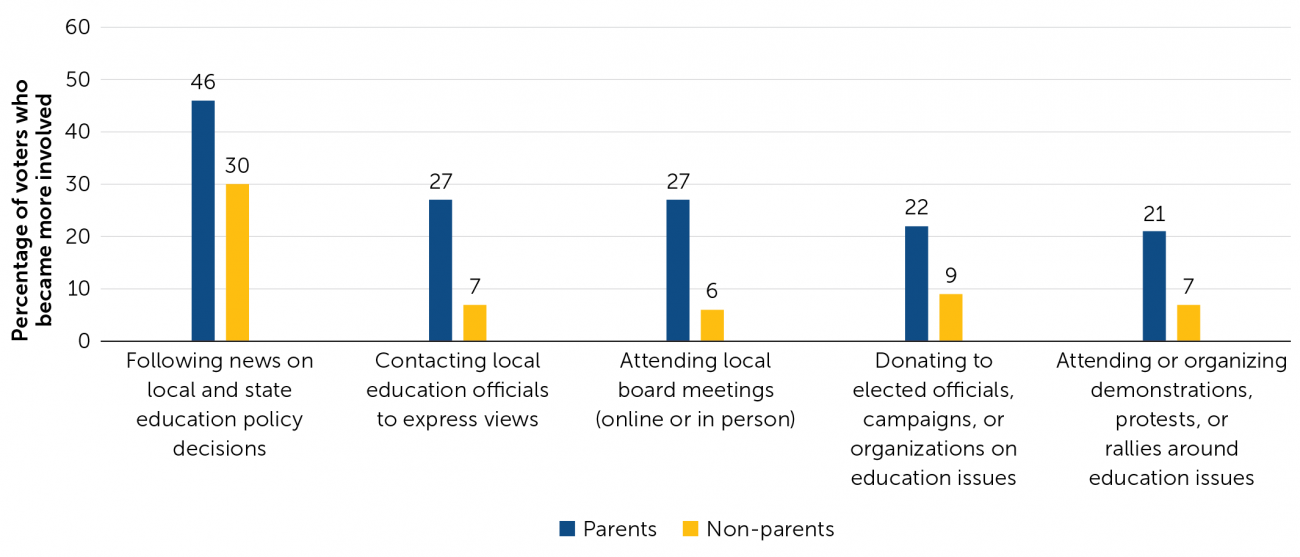
Yet involvement was also closely related to income (Figure 8). Voters making over $150,000 indicated that they had become more involved in each activity we surveyed, at rates higher than other groups. The opposite was true for those making under $35,000. Voters in the lowest income ranges instead became consistently less involved over the past year.
Figure 8. Voter Involvement in Public Activities This Year Compared to Before the Pandemic, by Income
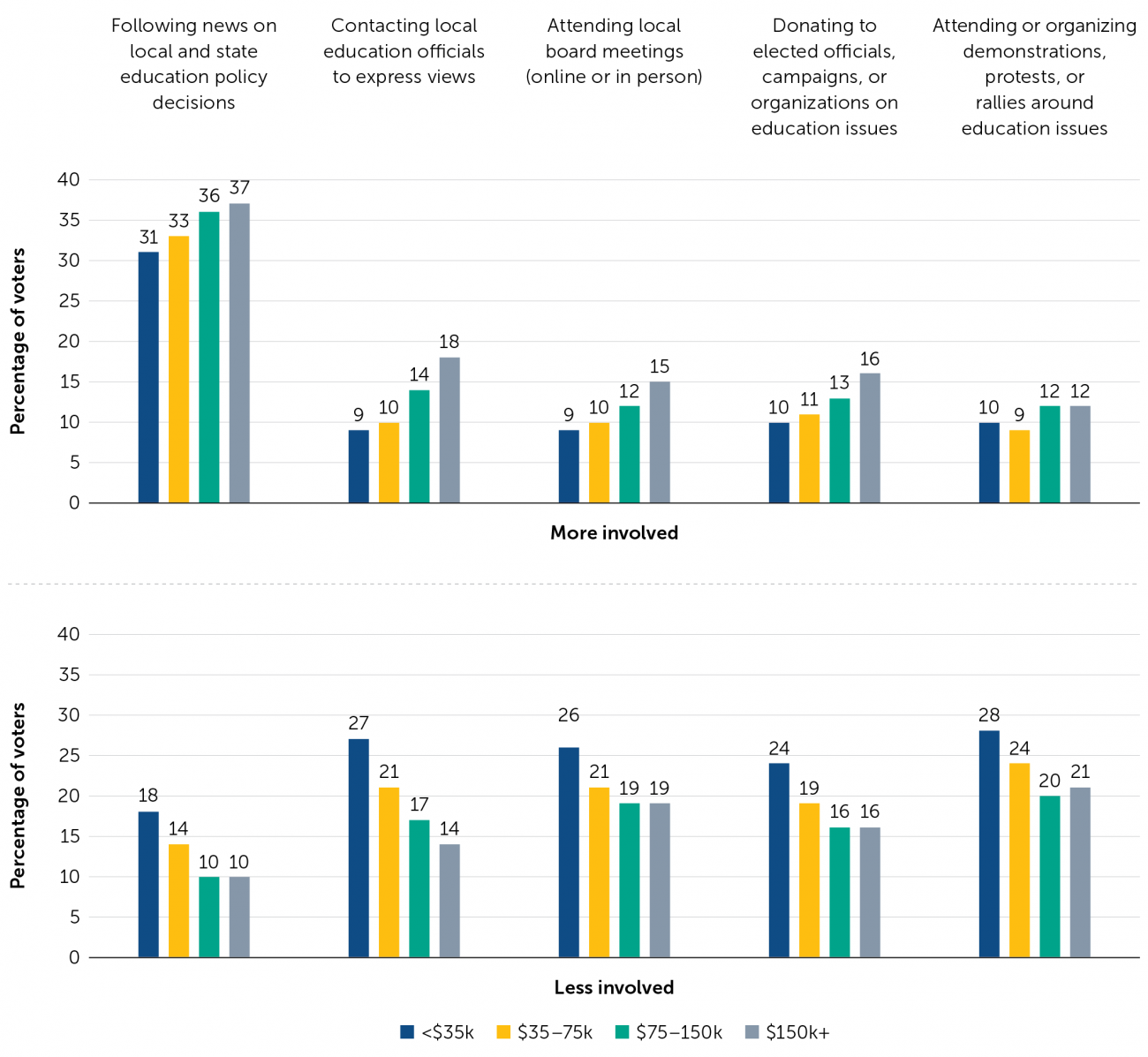
5 The biggest reported drivers of increased voter engagement in educational issues were dissatisfaction with education systems and increased prominence of education in public discourse
We asked voters who indicated that they had become more engaged in education issues this past year during the pandemic what reasons contributed to that engagement. Although researchers and media reports have suggested that the availability of online forums for political engagement could increase involvement, Figure 9 illustrates that only 24 percent of voters indicated it was important to their increased engagement. Instead, voters said they became more engaged for two main reasons: education issues had been more prominent in national and local news (43 percent) and dissatisfaction with the quality of education or unhappiness with educational decisions made during the pandemic (43 percent).
Figure 9 also shows that the reasons for engagement were divided along party and race lines, particularly so for dissatisfaction. While 53 percent of Republicans reported being more engaged because they were unhappy with educational decisions or dissatisfied with the quality of education, only 38 percent of Democrats reported being more engaged for these reasons. Dissatisfaction represented the single largest motivator for increased engagement among Black voters. While 51 percent of Black voters became more engaged due to dissatisfaction, this was true for 40 percent of White voters and only 35 percent of Asian voters.
Conversely, some voters were pushed to be more engaged by showing support for educators, but this motivation was divided along party lines. Of these voters who became more involved, 44 percent were Democrats compared to 21 percent who were Republicans.
Figure 9. Contributors to Increased Engagement in Education Issues During the Pandemic, by Party and Race/Ethnicity
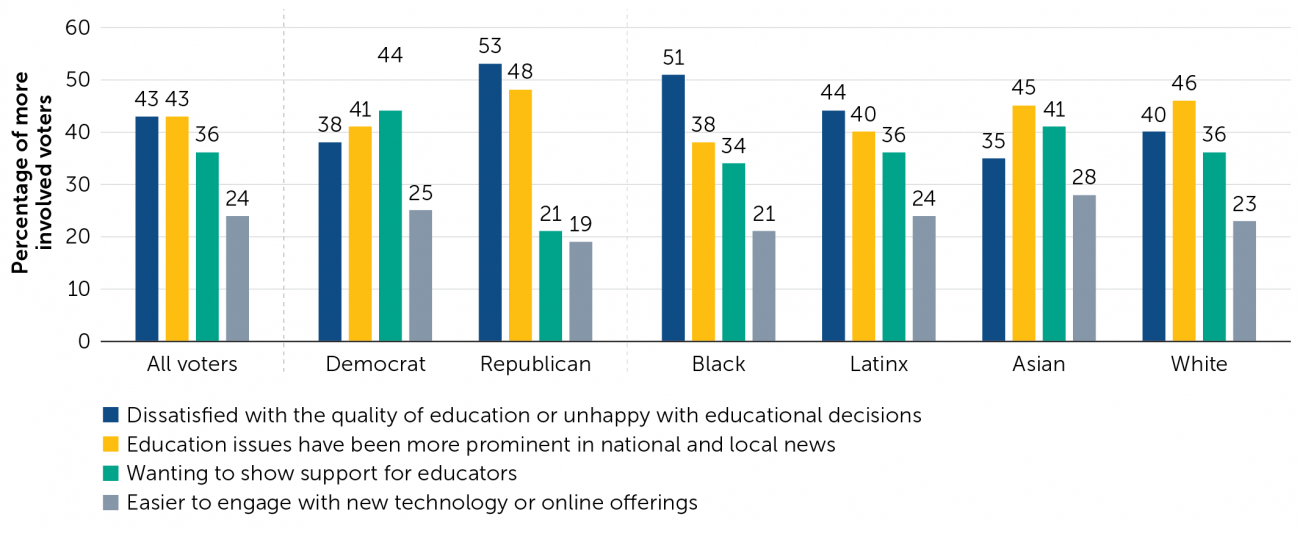
As Figure 10 shows, dissatisfaction and unhappiness with educational decisions were also substantial motivators for voters making under $35,000 per year, more than half of whom (56 percent) indicated they were more involved due to dissatisfaction or unhappiness, while this was true for far less than half of upper income voters.
Figure 10. Dissatisfaction and Unhappiness as Contributors to Increased Engagement in Education Issues During the Pandemic, by Income
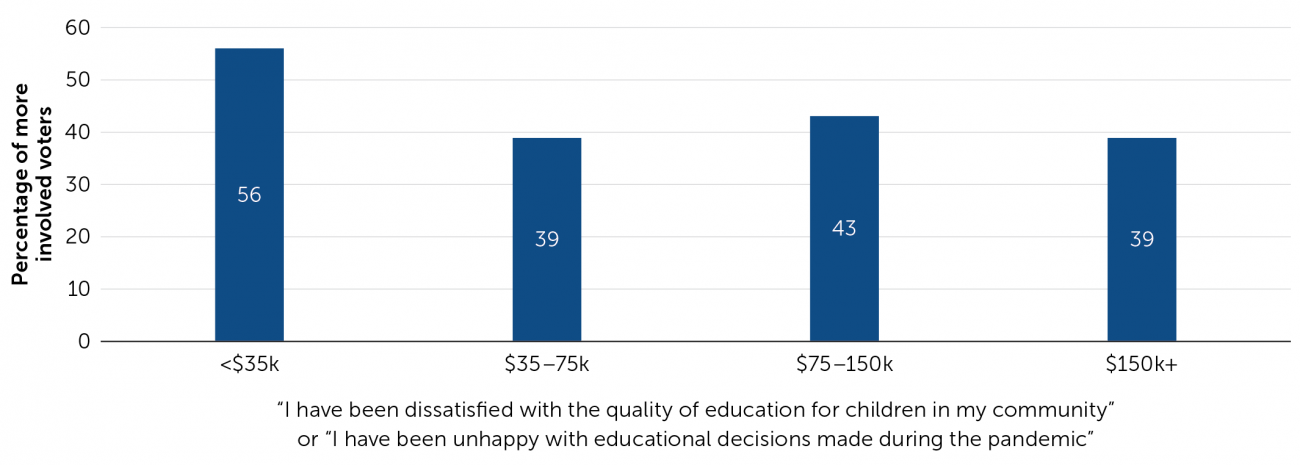
Discussion
The past year put a spotlight on the importance of local governance, as school boards made decisions with far-ranging impacts, from school closures and reopenings to addressing racial injustice. How well did these leaders fare in the eyes of their constituents, and how involved were voters in local educational decisions? The 2021 PACE/USC Rossier Poll indicates relatively high support for school boards among California voters. However, the past year appears to have challenged these positive perceptions, and when framed in the context of the pandemic, voter support for their school boards typically dropped substantially. Patterns of engagement also changed during this time. Some voters, particularly parents and higher income individuals, were becoming more engaged in educational issues. Many voters felt compelled to be more involved because they were unhappy or dissatisfied with educational systems, even as others wanted to engage but felt their input would not be valued.
The efficacy of the school board role is predicated on some baseline assumptions about the purpose of local democratic institutions, including proximity and responsiveness to their communities and representation of community needs. While our findings show that voters generally support boards and believe they have a critical role in educational decision-making, the results also raise questions about the extent to which school boards live up to these democratic ideals in practice. In this brief, we highlighted patterns of racial, socioeconomic, and partisan political divisions in many areas of school district governance. These persistent divides were observed in perceptions of school board effectiveness and handling of the pandemic, whether boards responded to community needs and valued community input, motivators for engagement, and patterns of involvement in political activities. Our findings also suggest that there are voters who do not trust their local school boards to respond to their needs and that voters are becoming more engaged due to dissatisfaction with board decisions. In particular, Black voters and low- income voters were most likely to report dissatisfaction and feel less valued by their local boards.
In the coming year, local school districts will be receiving an unprecedented influx of new federal and state funds. They will face critical decisions around health and safety, learning loss and remediation, and racial justice. As local leaders grapple with spending these funds and addressing students’ varied social, emotional, and academic needs in the wake of the pandemic, we must monitor how the divisions, mistrust, and dissatisfaction that surfaced in this poll affect their decisions. As we transition from pandemic to recovery, it will also be important to track how school boards engage local stakeholders and which constituents’ voices are privileged in these important conversations.
Alonso, J. D., Marsh, J. A., & Daramola, E. J. (2021, August). Voter engagement and satisfaction with California’s local school governance: Evidence from the 2021 PACE/USC Rossier poll [Policy brief]. https://edpolicyinca.org/publications/voter-engagement-and-satisfaction-californias-local-school-governance



